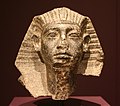State Museum of Egyptian Art
 Joint construction of the University of Television and Film Munich and the State Museum of Egyptian Art; the entrance to the museum is on the right front |
|
| Data | |
|---|---|
| place | Munich |
| Art | |
| opening | 1966 |
| operator | |
| management | |
| Website | |
| ISIL | DE-MUS-099218 |
The State Museum of Egyptian Art ( SMAEK ) in Munich is one of the most important in Germany alongside the collections in Berlin ( Egyptian Museum ) and Hildesheim ( Roemer and Pelizaeus Museum ). It shows exhibits from all epochs of ancient Egypt up to the Coptic (Christian) period, as well as some exhibits from neighboring cultures in Nubia , Assyria and Babylonia .
It is located together with the University of Television and Film in the Munich art area in a building designed by the architect Peter Böhm .
The Free State of Bavaria is the sponsor . Sylvia Schoske is the director of the State Museum of Egyptian Art .
history
The collection goes back among other things to various Aegyptiaca Bavarian rulers, u. a. that of Duke Albrecht V from the second half of the 16th century in the Royal Antiquarium in Munich, that of Elector Karl Theodor (initially in Mannheim, also in the Antiquarium from 1808) and that of Crown Prince Ludwig (initially in the "Egyptian Hall" of the Glyptothek) ). In 1816 Ludwig in Paris bought works of art that Napoleon had taken with him from Rome. He also bought memorial stones of the Middle and New Kingdom from Captain Ferdinand Michel and the botanist and traveler Franz Wilhelm Sieber and pieces from the collections of Edward Dodwell and Bernardino Drovetti as well as part of the jewelery treasure of Queen Amanischacheto by Giuseppe Ferlini for the collection . The Royal Museums in Berlin later bought the rest of the treasure. The Royal Bavarian Academy of Sciences acquired additional objects in the 19th century. At the beginning of the 20th century, civil patrons and patrons contributed other works of art, such as the Egyptologist Friedrich Wilhelm von Bissing , as well as scientific institutions such as the German Orient Society and the Egyptian Antiquities Administration , and later private individuals such as Wilhelm Esch-Duisburg and Heinz Herzer. At the moment, more and more works from the budget of the Free State of Bavaria , through foundations and the Friends of the Egyptian Museum in Munich, founded in 1976. V. acquired.
The museum emerged from the "Egyptian Collection of the Bavarian State", which was founded in 1966. Part of the collection was shown from July 21st to October 5th, 1966 in the Haus der Kulturinstitute . On July 15, 1970, a new exhibition of a first part with older works opened in the ballroom building of the Munich Residence in the “four-storey hall” and the wing to the east. On June 28, 1972, the wing to the west of the “four-storey hall” was opened with works from the late Egyptian period of the 1st millennium BC. They were exhibited there until 2013. From 2000 to the end of 2009 there was also a branch museum of the Munich facility at Seefeld Castle near Lake Ammersee . Since June 11, 2013, the museum has been located in the new building opposite the Alte Pinakothek . At the end of December 2013, the Münchner Abendzeitung awarded the museum the “Star of the Year” in the “Art” category. In the past, over 50 special exhibitions have been shown.
Exhibition and museum building
For conservation reasons, the rooms specially built for the museum are located in the basement of the building and are accessed via a wide flight of stairs that lead to a protruding, protruding wall made of exposed concrete. The whole building is made of exposed concrete and glass, individual elements are made of brushed aluminum. Rooms for two studios and an auditorium branch off from the lobby, as well as the usual facilities such as a cloakroom and museum shop. There is another long ramp down to the collection.
The sculpture Present Continuous by Henk Visch stands in front of the building .
The exhibition is divided into two main areas. The first gives an insight into the various artistic forms of expression in Egyptian sculptures. It is not structured chronologically, but presents comparable exhibits side by side and invites you to view them together. This area winds around an atrium that brings daylight into the exhibition and ends with the obelisk of Titus Sextius Africanus . This is 5.80 meters high; the middle part dates from the year 50. The rest was added later and restored several times.
A gallery serves as a transition to the thematic part of the collection, which shows the development of Egyptian art over 5000 years. The other, much smaller halls show related exhibits according to thematic structure. These include, for example, belief in the hereafter , religion, writing and text or handicrafts. This sequence of rooms ends with art from neighboring regions, Nubia and the ancient Orient. Another adjoining room is used for special exhibitions.
The exhibits are labeled with the central data, each room has an introductory text written directly on the concrete wall. At the central locations of the exhibition are multimedia cubes with a large touchscreen surface, they convey relationships, offer background texts on exhibits or topics and, in some cases, enlarged photos of objects. These can be from the museum's collection itself or outstanding objects from other collections such as the Egyptian Museum Berlin . A portable multimedia guide can be borrowed in the lobby; it provides further information on around 200 exhibits.
Outstanding works of art
The collection includes in particular works of ancient Egyptian art from the time of the Pharaohs, exhibits from Egypt in the Greco-Roman period , works of Coptic art from the Christian era as well as excavations of Near Eastern archeology beyond Egypt.



- Grave finds Minschat Abu Omar
- Old Kingdom approx. 2707–2216 BC Chr.
- Double statue of Niuserre as a young and an old man, little head that probably represents Cheops , granite family group of the Dersenet, false doors from the tomb of Menes
- Shabti figure made of wax
- Middle Kingdom approx. 2010–1793 BC Chr.
- Several portraits of Pharaoh Amenemhet III. , Cult image of the crocodile god Sobek, faience hippopotamus with stylized water plants, sphinx figure Sesostris III. , Statue of a high official
- New Kingdom approx. 1532-1070 BC Chr.
- Portraits of the pharaohs Ramses II , Thutmose III. , Akhenaten and Hatshepsut , lions head made of limestone, head of a sphinx Amenophis II , knee figure of Senenmut , gold figure of Teje , dice statue of Bekenchon, chalice with the inscription Thutmosis III, the oldest glass vessel in the world (1450 BC).
- Mummy coffins
- Sculptures from the late period, upper part of a priest statue from the Persian period (approx. 500 BC), sculptures from the Ptolemaic and Roman epochs including an Osiris bronze group, a statue torso (around 350 BC), the granite head of a Seleucid ruler and a Torso of Antinous from Roman times
- Nubian art
- Late gold treasure of the Nubian queen Amani-schaheto
- Coptic art
- In particular, painted ceramics and glass as well as fabrics
- Assyrian art
- Since moving out of the war-torn Assyrian Hall of the Glyptothek , the Assyrian reliefs have also been here, such as the orthostatic reliefs from the palace of Assurnasirpal II from Nimrud (acquired by Ludwig I in London)
- Babylonian art
- Walking lion made of glazed tiles from the processional street in front of the Ishtar Gate from Babylon (approx. 570 BC), a purchase from the Museum of the Near East in Berlin
- The collection also includes eleven Aegyptiaca, which are new creations from the second half of the 18th century in Egyptian style.
Pharaoh Thutmose IV.
literature
- Mate. News from the State Museum of Egyptian Art in Munich. (Journal, published since 2016), ISSN 2510-3652
- Sylvia Schoske , Dietrich Wildung : The Munich book of Egyptian art. Beck, Munich 2013, ISBN 978-3-406-64528-0 .
Movie
- Pharaohs for Munich - Egyptian Museum for the opening. Documentary, Germany, 2013, 43.50 min., Script and director: Henning Weber, production: Bayerischer Rundfunk , series: Lido, first broadcast: June 13, 2013 on Bavarian television , synopsis with photo series from BR.
Web links
- Website of the State Collection of Egyptian Art
- Literature from and about the State Museum of Egyptian Art in the catalog of the German National Library
- Selected works of art from the State Museum of Egyptian Art in 3D
See also
Individual evidence
- ↑ a b smaek.de
- ^ A b Egyptian Collection of the Bavarian State (ed.): The Egyptian Collection of the Bavarian State . Munich 1966.
- ↑ Acquisitions. State Museum of Egyptian Art, accessed April 30, 2019.
- ^ Location Seefeld. In: smaek.de, accessed on August 3, 2013.
- ↑ Now it goes down to the light. In: FAZ . June 14, 2013, p. 34, beginning of article.
- ↑ Star of the year 2013: Art: Museum Ägyptischer Kunst. In: evening newspaper. December 26, 2013.
- ↑ Archive: Exhibitions . In: State Museum of Egyptian Art, accessed June 19, 2016.
- ↑ Walter Andrae : Memoirs of an excavator. 2nd Edition. Stuttgart 1988, ISBN 3-7725-0457-4 , p. 277.
- ^ Alfred Grimm: Aegyptiaca from the Royal Antiquarium . In: Munich Yearbook of Fine Arts . tape 45 , 1994, pp. 7-64 .
Coordinates: 48 ° 8 ′ 50.1 ″ N , 11 ° 34 ′ 6.6 ″ E





